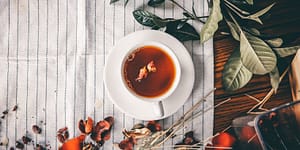The Taste of Herbalism: What Your Tongue is Telling You

If you’ve ever cooked with herbs, you know that taste plays a huge role when deciding which ones to use. It’s much the same when using herbs medicinally. The taste of an herb actually tells us quite a bit about the medicinal properties of the plant. We’re covering the most common tastes found in herbs and what they mean.
The following is an excerpt from Energetic Herbalism by Kat Maier. It has been adapted for the web.

While most energetic traditions share five basic tastes of spicy, sweet, bitter, sour, and salty, there are slight variations, such as the addition of astringency in Ayurveda. Let’s consider each of these, plus a few others that are useful for understanding energetics of a plant.
Spicy/Pungent
ENERGETICS: WARMING, MOVING, DRYING
Stimulating, spicy plants increase circulation and wake up our senses. This is why most culinary herbs are pungent: They help increase digestive action. Aromatics like rosemary and thyme are warming and drying, reflecting the Mediterranean ecosystem they come from. The energy of fire and air from pungent medicines is also specific for lungs, as these elements disperse energy in an outward direction. Eating spicy foods, such as horseradish or cayenne, can initiate a sweat, which is a common expression of dispersing energy outward. These herbs can be quite stimulating, so usually they are used in low doses. Pungent examples include black pepper (Piper nigrum), ginger, garlic (Allium sativum), cinnamon (Cinnamomum verum), and cayenne.
Sweet
ENERGETICS: BUILDING, NUTRITIVE, BALANCING
Sweet is the subtle flavor of grains and roots. Traditionally, even honey would have been considered excessively sweet and used in moderation. Energetically speaking, the direction of this flavor is upward because these plants tonify, build, and energize. Nourishing roots and adaptogens are sweet-tasting plants due to the presence of complex sugars called polysaccharides. Sweet herbs tend to be anti-inflammatory and demulcent, especially when the content of mucopolysaccharides is high. Most saponin-rich adaptogens are sweet as well. This is the energy of earth and water. Examples of these tonics are American ginseng (Panax quinquefolius), licorice, and astragalus (Astragalus membranaceus). Blood-building herbs such as red clover (Trifolium pratense) and burdock are also sweet.
Bitter
ENERGETICS: CALMING, COOLING, CLEARING
Bitter flavor has a downward, drying, and clearing action. Bitter cools and clears heat from the body and aids in cases of inflammation. The bitter principle stimulates bile and helps with digestion as well as elimination. In Chinese medicine, this flavor is said to go to the heart. In Out of the Earth, British phytotherapist and author Simon Mills wrote, “Repeatedly in the records of traditional plant medicine, we find that bitter remedies are the ‘true stimulants’, a notion surviving in the modern idiom that ‘nasty- tasting medicines are the best for you’.”3 The bitter receptors on the tongue stimulate a reflex response that provokes an amazing array of actions: increased appetite, increased bile flow, production of hydrochloric acid and digestive enzymes, protected gut tissues, balanced blood sugar, clearing of dampness from the digestive tract, and a low-level antimicrobial action. Bitter herbs include dandelion (Taraxacum officinale), blue vervain (Verbena hastata), and motherwort.
Sour
ENERGETICS: COOLING, ASTRINGING
The direction of sour moves energy inward and downward. Think cooling, natural lemonade in expansive summer heat. The sour flavor of herbs, though, is more subtle than the intensity of lemons. This flavor is represented by herbal fruits such as bilberry (Vaccinium myrtillus), sumac (Rhus spp.), and schisandra (Schisandra chinensis). Their energies astringe tissues or bind excesses. Sour antioxidants (flavonoids) cool the tissues and are actually protective against oxidative stress (heat). Sour foods include vinegar and limes, as well as most fermented foods.
Astringent
ENERGETICS: COOLING, DRYING
Astringent is recognized as a taste in Ayurveda, but in other systems it is considered more as a sensation rather than a flavor. Either way, the mouth definitely recognizes the presence of an astringent food or herb. Astrin- gent herbs are drying to the body and tonifying to the skin and mucous membranes. Most herbs are slightly astringing due to the presence of tannins. These compounds are prevalent in plants because they are part of the plant’s immune response to disease. These compounds precipitate protein and tone inflamed or boggy tissue. Astringent herbs are offered to people who have diarrhea or excessive bleeding and who tend toward dampness, excessive sweating, and secretion. Herbs include witch hazel leaf (Hamamelis virginiana), black tea leaves (Camellia sinensis), and blackberry root (Rubus fruticosus).
Salty
ENERGETICS: COOLS, MOISTENS, SOFTENS
This flavor is described as having a downward direction and is specific for directing energy to the kidney. Because water follows salt, these plants are used to soften hard swellings. In herbalism, salty herbs such as dandelion leaf, chickweed, plantain, and nettle are also mineral-rich plants that are packed with nutrients. Common salty foods are seaweed, kelp, miso, and soy sauce. Herbs with this flavor can also be drying; there are many diuretics in this group. However, other mineral-rich plants, such as chickweed, moisten tissues. Traditionally, salt was a tonic for the heart because it increases fluid and improves blood volume, especially in hotter weather where fluid loss can lead to mineral deficiency.
 Acrid
Acrid
ENERGETICS: WARMING, MOVING, DISPERSING
Acrid plants are the main category of herbs to release patterns of tension. This flavor is actually more of an experience, as it provokes a reaction in our tissues. The felt impression is one of warmth and tingling, a prickly and some may say nauseating reaction. These herbs are generally offered in low doses, yet have a profound physiological effect. Lobelia (Lobelia inflata) is the quintessential acrid herb and is that perfect blend of contradiction—it is dispersing as well as relaxing. Many of the antispasmodic herbs are acrid, such as kava kava root (Piper methysticum), black cohosh (Actaea racemosa), and cramp bark (Viburnum opulus).
Bland
ENERGETICS: NEUTRAL, MOISTENING
Bland herbs are as they sound, mostly neutral in energy. It is said they move through the body with relative ease, thus having their effect on the urinary system. Hence, they can act as diuretics. Often, they are demulcent in nature and have a slippery texture associated with mucilage. Bland herbs are oatstraw (Avena sativa) and corn silk (Zea mays).
Recommended Reads
Recent Articles
Want to start your own medicinal herb garden? Passionflower, lemon balm, and goldenseal are great places to begin! These herbs are jam-packed with medicinal properties and easy to grow in a majority of climates.
Read MoreSprouts are easy to cultivate, mature quickly and pack a nutritional punch! You can make nutrient-rich sprouts from all kinds of edible seeds in your kitchen.
Read MoreSuffering from frequent headaches is miserable and immobilizing. If you haven’t had luck treating and preventing your headaches, skip the over-the-counter approach and prepare herbal formuals for migraines to use in the future! The following is an excerpt from Herbal Formularies for Health Professionals, Volume 4 by Jill Stansbury. It has been adapted for the…
Read More“It is more important to know what kind of person has a disease than to know what kind of disease a person has.” —Hippocrates Drawing on her decades of clinical experience and her extensive research, Dr. Jill Stansbury offers an unparalleled range of herbal formulas in her five-volume set, Herbal Formularies for Health Professionals. For each…
Read More

 Acrid
Acrid







